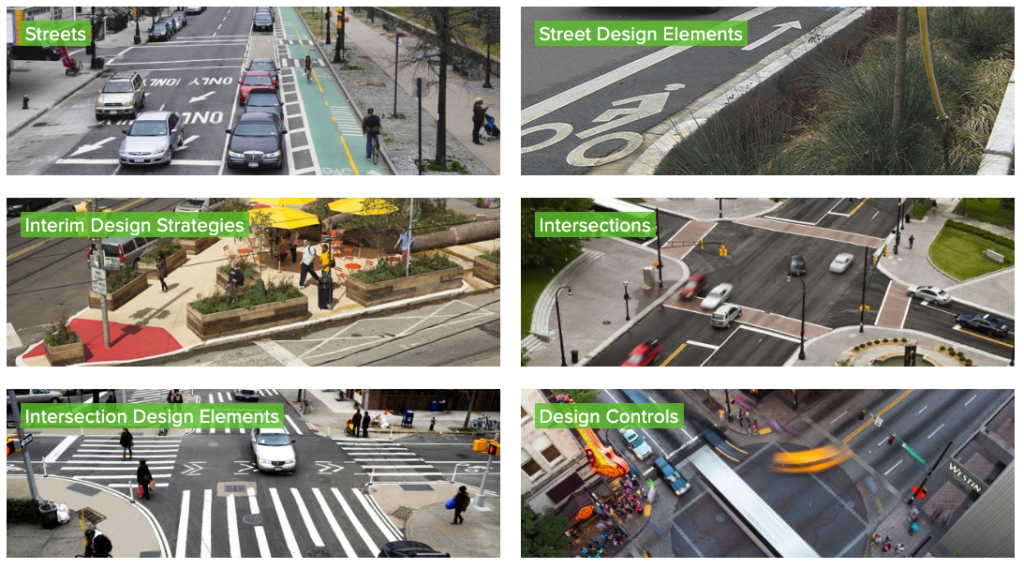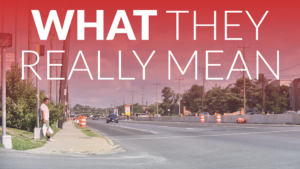Related Resources
Community Connectors Portal: Tools for advocates > What they really meanDesign standards 101
Things DOTs say: “Design standards don’t allow that”
Street design is dictated by several layers of standards and manuals written by federal, state, and local governments. If your local or state department of transportation (DOT) is telling you that “Our street and road design standards don’t allow that,” they might be reading the wrong ones, claiming things that aren’t actually true or even required by federal standards, or unwilling to interpret their standards in any “unorthodox” way.
You as an advocate have the power to influence the way design standards are used.
Federal standards: The MUTCD
The MUTCD, or the Manual on Uniform Traffic Control Devices, is published by the Federal Highway Administration (FHWA) and defines the standards and associated justifications used by road managers nationwide to install and maintain traffic control devices on all public streets, highways, bikeways, and private roads open to public travel. What are traffic control devices? They include stop signs, traffic lights, crosswalks, and other things that tell you the rules of the road. The purpose of the MUTCD is to ensure that these things are standardized so that things, like stop signs, look the same everywhere and are easy to read and understand.
Like most rules and standards, the MUTCD is written with vehicle flow and driver convenience in mind. However, it is not set in stone. While enforced by federal law, the MUTCD is also updated once every four years. In fact, a new version is under review now and could be published in late spring or early summer.
Also, while state DOTs often fear any deviation from the MUTCD, cities are far more experimental. Cities like St. Louis, MO and Ames, IA have deviated from the MUTCD’s strict and sterile approach to crosswalks to build more eye-catching designs that also reflect the history of the local area. If they could do it then your area can too.
Flickr photo by SDOT Photos. Decorative crosswalk being installed in Seattle on Greenwood Ave N at N 81st St.
State standards: The AASHTO Green Book
The main guide used by road designers is the Policy on Geometric Design of Highways and Streets, known colloquially as the Green Book, which is published by the American Association of State Highway and Transportation Officials (AASHTO). The Green Book is often described as the “pre-eminent industry guide to current highway and street design research and practices.” AASHTO also publishes the Highway Safety Manual, which focuses more specifically on safety interventions and design.
FHWA adopts both of these manuals as their own through federal regulations that require AASHTO resources to be consulted on all projects within the National Highway System. The Green Book in particular is responsible for a bevy of road design standards that prioritize vehicle speed over the safety and accessibility of other users, including recommended minimum lane widths and roadway classifications. If you have heard that a lane has to be 12 feet wide, that idea probably comes from that engineer’s interpretation of the Green Book.
Seeking alternatives
States often adopt a version of the Green Book with their own changes, so states do not have their hands tied by federal regulations that don’t work for their state. Some states have created whole new approaches to roadway design, including Florida DOT that has written a Context Classification Manual setting road designs based on the context of the community as part of a broad and aggressive Complete Streets effort.
There are also other design manuals. The National Association of City Transportation Officials (NACTO) publishes its own manual—the Urban Street Design Guide—which covers best practices for promoting walkability, public transit, and traffic calming. The NACTO guide is written with designs that are in compliance with the Green Book, even if state DOTs rarely use the flexibilities that NACTO allows. This also has the benefit of not requiring the long, laborious exceptions process for more modern designs contained in the Urban Street Design Guide that an area might want to utilize regularly.

Finally, exceptions to the standards can be made on a project-by-project basis. Unfortunately, winning these exceptions can be a long process that usually causes major delays to the project. As a result, project staff will usually resist this. It is better to seek changes to the standards so that you don’t have to fight for these changes project by project.
What can I do?
If you were told your project “doesn’t meet standards,” ask whether that’s really the case. Which standards are they citing? Make them show you the specific language and, if they provide you with something, see if you agree with their interpretation. There’s a long history of states claiming that “FHWA doesn’t permit X” when that’s not actually true. If this project really violates the MUTCD or Green Book, is there a way to alter the project to adhere to standards while maintaining the project’s purpose? Did they consult other guidebooks, like NACTO’s Urban Street Design Guide?
Encourage your city to adopt the Urban Street Design Guide. The 2021 infrastructure changed the law to allow cities to adopt and use safer street design guidelines approved by the FHWA, such as the Urban Street Design Guide from the National Association of City Transportation Officials (NACTO), even if a state has prohibited cities from doing so. State DOTs are more likely to pivot from the orthodox design guides if they know the alternative is well-thought-through and not just a “no” to their approach.
If you need to push for an exception, do it. If opposition to a project will delay the project anyway, the transportation agency might be more open to taking on the exceptions process. Don’t take no for an answer.







